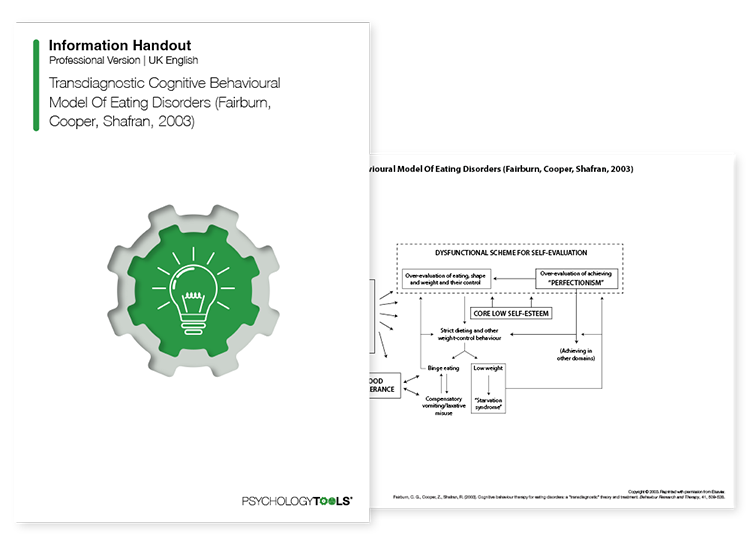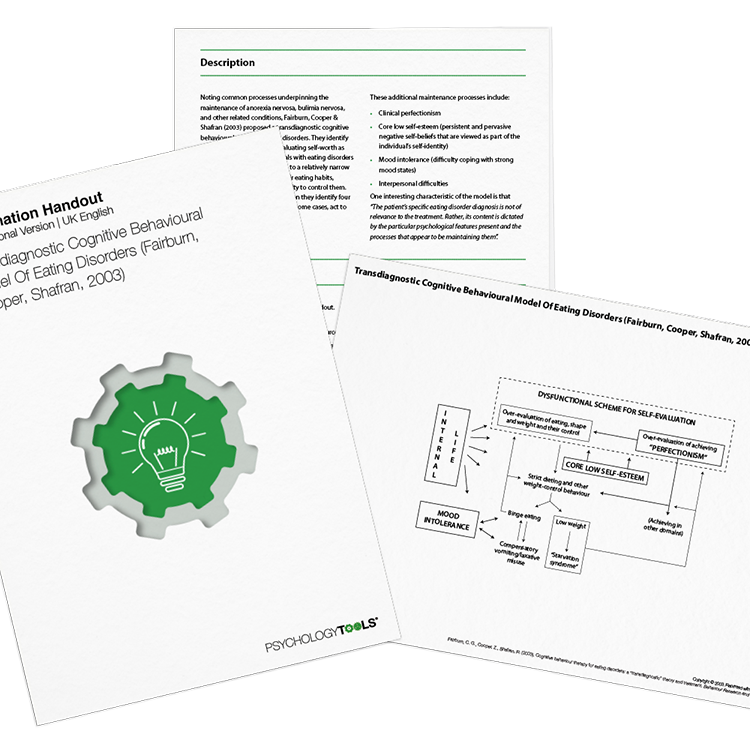Professional version
Offers theory, guidance, and prompts for mental health professionals. Downloads are in Fillable PDF format where appropriate.
A licensed copy of the Fairburn, Cooper, and Shafran (2003) transdiagnostic cognitive behavioral model of eating disorders, outlining common processes maintaining eating disorders.

Offers theory, guidance, and prompts for mental health professionals. Downloads are in Fillable PDF format where appropriate.

The Transdiagnostic Cognitive Behavioral Model Of Eating Disorders, proposed by Fairburn, Cooper, and Shafran, identifies shared mechanisms underpinning conditions like anorexia nervosa and bulimia nervosa. Central to this model is a dysfunctional system for self-evaluation, where individuals overly focus on eating habits, shape, and weight. This model provides insights into these processes, assisting professionals in tailoring treatments to the psychological features present.
Dysfunctional self-evaluation based on weight and shape.
Challenges with self-worth tied to eating and weight control.
Perfectionism and emotional dysregulation issues.
General interpersonal and mood-related maintenance processes.
Understand more about the transdiagnostic model.
Use the model as a template to organize your case formulations.
Use your knowledge of the model to explain maintenance processes to clients.
Engage clients in discussions about their beliefs and behaviors.
Customize interventions based on individual maintenance mechanisms.
Use in supervision to discuss formulation and treatment plans.
The transdiagnostic cognitive behavioral model developed by Fairburn, Cooper, and Shafran (2003) identifies shared maintenance processes across a wide range of eating disorders. Central to the model is the idea that individuals with eating disorders tend to base their self-worth predominantly on eating, shape, and weight, and their perceived ability to control them. This dysfunctional self-evaluation system can lead to different features of eating disorders such as strict dietary restraint, preoccupation with weight and body image, and compensatory behaviors such as binge eating and purging.
Recognizing that many individuals do not fully recover with standard treatments, the authors proposed an extended model that accounts for additional maintaining factors. These include perfectionistic standards, pervasive low self-esteem, difficulty managing intense emotional states, and problematic interpersonal relationships. These processes interact with the core psychopathology and often present barriers to treatment progress.
The transdiagnostic model recommends that clinicians assess which psychological processes are active for each individual and tailor treatment accordingly. This framework not only explains why people frequently move between diagnostic categories over time, but also helps guide more comprehensive and individualized interventions. The model underpins enhanced CBT (CBT-E), a flexible treatment approach now widely used across the spectrum of eating disorders.

Just enter your name and email address, and we'll send you Transdiagnostic Cognitive Behavioral Model Of Eating Disorders (Fairburn, Cooper, Shafran, 2003) (English US) straight to your inbox. You'll also receive occasional product update emails wth evidence-based tools, clinical resources, and the latest psychological research.
Working...
This site uses strictly necessary cookies to function. We do not use cookies for analytics, marketing, or tracking purposes. By clicking “OK”, you agree to the use of these essential cookies. Read our Cookie Policy